
Anthozoa is a class of marine invertebrates which includes the sea anemones, stony corals and soft corals. Adult anthozoans are almost all attached to the seabed, while their larvae can disperse as part of the plankton. The basic unit of the adult is the polyp; this consists of a cylindrical column topped by a disc with a central mouth surrounded by tentacles. Sea anemones are mostly solitary, but the majority of corals are colonial, being formed by the budding of new polyps from an original, founding individual. Colonies are strengthened by calcium carbonate and other materials and take various massive, plate-like, bushy or leafy forms.
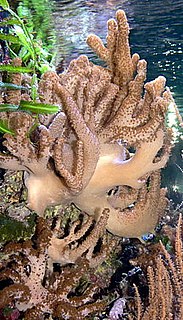
Alcyonacea, or soft corals, are an order of corals. In addition to the fleshy soft corals, the order Alcyonacea now contains all species previously known as "gorgonian corals", that produce a more or less hard skeleton, though quite different from "true" corals (Scleractinia). These can be found in suborders Holaxonia, Scleraxonia, and Stolonifera. They are sessile colonial cnidarians that are found throughout the oceans of the world, especially in the deep sea, polar waters, tropics and subtropics. Common names for subsets of this order are sea fans and sea whips; others are similar to the sea pens of related order Pennatulacea. Individual tiny polyps form colonies that are normally erect, flattened, branching, and reminiscent of a fan. Others may be whiplike, bushy, or even encrusting. A colony can be several feet high and across, but only a few inches thick. They may be brightly coloured, often purple, red, or yellow. Photosynthetic gorgonians can be successfully kept in captive aquaria.

Hexacorallia is a class of Anthozoa comprising approximately 4,300 species of aquatic organisms formed of polyps, generally with 6-fold symmetry. It includes all of the stony corals, most of which are colonial and reef-forming, as well as all sea anemones, and zoanthids, arranged within five extant orders. The hexacorallia are distinguished from another class of Anthozoa, Octocorallia, in having six or fewer axes of symmetry in their body structure; the tentacles are simple and unbranched and normally number more than eight. These organisms are formed of individual soft polyps which in some species live in colonies and can secrete a calcite skeleton. As with all Cnidarians, these organisms have a complex life cycle including a motile planktonic phase and a later characteristic sessile phase. Hexacorallia also include the significant extinct order of rugose corals.
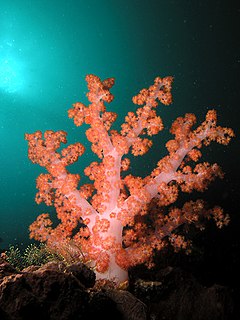
Octocorallia is a subclass of Anthozoa comprising around 3,000 species of water-based organisms formed of colonial polyps with 8-fold symmetry. It includes the blue coral, soft corals, sea pens, and gorgonians within three orders: Alcyonacea, Helioporacea, and Pennatulacea. These organisms have an internal skeleton secreted by mesoglea and polyps with eight tentacles and eight mesentaries. As with all Cnidarians these organisms have a complex life cycle including a motile phase when they are considered plankton and later characteristic sessile phase.

Coralliidae, also known as precious corals, is a taxonomic family of soft corals belonging to the phylum Cnidaria of the family Scleraxonia. These sessile corals are one of the most dominant members of hard-bottomed benthics environments such as seamounts, canyons and continental shelves. From this coral family results 69 descendants in which each species plays a key role in forming habitats for a variety of marine species. Due to their unique trait of possessing a red calcium carbonate skeleton, these corals can be harvested in order to create handcrafted amulets, jewelry and other valuable artifacts giving rise to its reputed name of "precious corals". Correspondingly, members of this family are vulnerable to the negative impacts of overharvestation imposed by mass coral trade.

Helioporacea is an order of the subclass Octocorallia that forms massive lobed crystalline calcareous skeletons in colonial corals. These corals first appeared in the Cretaceous period. It consists of two families, Helioporidae Moseley, 1876 and Lithotelestidae Bayer & Muzik, 1977.
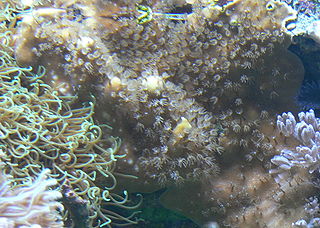
Heliopora is a genus of cnidarian in the monotypic family Helioporidae. It is a reef building hard coral but belongs to the subclass Octocorallia and is therefore most closely related to soft corals, sea pens, fan corals and sea whips and not to the main reef-building Scleractinian corals, which belong to subclass Hexacorallia. Currently only three species are known, one of which is known only from fossils:

Gorgoniidae is a family of soft corals, a member of the subclass Octocorallia in the phylum Cnidaria. Nearly all the genera and species are native to the east and west coasts of America.

Gersemia is a genus of soft corals in the family Nephtheidae. Species in this genus are found in cold temperate and polar seas at depths ranging from 20 metres (66 ft) to over 2,000 metres (6,600 ft). The type species is Gersemia loricata.

Gersemia rubiformis, commonly known as the sea strawberry, is a species of soft coral in the family Nephtheidae. It is found in the northwest Atlantic and the northeast Pacific Oceans.
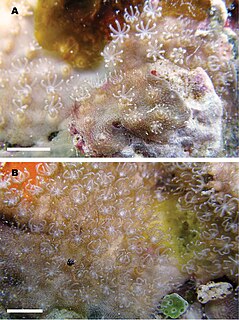
Lithotelestidae is a family of coral in the order Helioporacea. It was erected in 1977 by Frederick Bayer and Katherine Muzik. It is characterized by a crystalline aragonite skeleton formed by stolons and calices, cylindrical calices with secondary lateral calices, and fully retractable polyps with an exoskeleton formed of calcite capstans and crosses.
Primnoa wingi is a species of soft coral in the family Primnoidae.
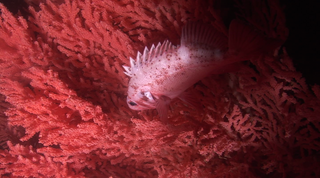
Primnoa(Lamororux, 1812) also known as red tree coral, is a genus of soft corals and the type genus of the family Primnoidae (Milne Edwards, 1857). They are sessile, benthic cnidarians that can be found in the North Pacific, North Atlantic, and Subantarctic South Pacific, and its members often play a vital ecological role as keystone species within their environment as a habitat and refuge for the megafauna that also inhabit those regions. This, in combination with their slow growth, makes the increasing disturbance to their habitats caused by fishing activities particularly impactful and difficult to recover from.

Eunephthya is a genus of soft corals in the family Nephtheidae. The genus is only known from South Africa

Anthelia glauca, the giant anthelia, is a species of soft coral in the family Xeniidae. It is a colonial species and is found in shallow water in the Indo-Pacific region.

Briareum is a genus of soft corals in the family Briareidae. The coral is cultivated by aquarium owners for its fluorescing polyps, which reveal themselves under actinic light. The genus is in need of extensive examination, as many specimens sold by marketers display unique and similar characteristics, but are often labeled as one species, Pachyclavularia violacea.
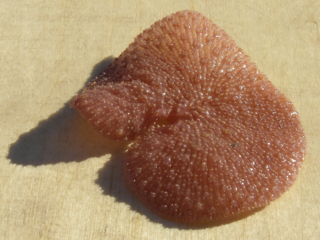
Renilla muelleri is a species of sea pansy. It has been reported from the Gulf Coast of the United States, notably the Florida panhandle, but is also reported from the eastern coast of South America. It is thought to be a euryhaline littoral species, found to a depth of up to 150 meters.
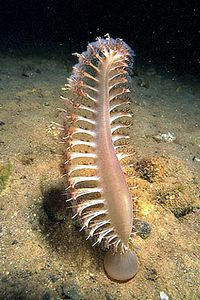
Pennatula is a genus of sea pens in the family Pennatulidae. The genus contains several bioluminescent species, including Pennatula rubra, Pennatula phosphorea, and Pennatula aculeata.

Umbellula is a genus of cnidarians in the monotypic family Umbellulidae. The genus contains bioluminescent species.

Gersemia juliepackardae is a species of soft coral in the family Nephtheidae. It is found in the northeast Pacific Ocean, on seamounts or on the deep ocean bed. The coral is named in honour of Julie Packard, the executive director of the Monterey Bay Aquarium, for "her dedication to ocean stewardship and conservation, and for elevating public awareness about the ocean environment."



















